诊断试验的评价
常用诊断试验评价指标计算及意义

似然比(likelihood ratio, LR) 是反映真实性的一种 指标,属于同时反映灵敏度和特异度的复合指标。即有 病者中得出某一筛检试验结果的概率与无病者得出这一 概率的比值。该指标全面反映筛检试验的诊断价值,且 非常稳定。似然比的计算只涉及到灵敏度与特异度,不 受患病率的影响。
诊断试验的评价指标
诊断试验(diagnostic test)
诊断试验是把可疑有病但实际无病的人 与真正的病人区分开来的过程。
一、筛检或诊断试验的真实性评价
金标准
特 定 人 群
病人
非病 人
待评价筛 查方法
阳 性 阴 性
阳性
阴性
评价指标
(一)真实性评价
• 测量值与真实值的符合程度。 • 灵敏度 、特异度、漏诊率、误诊率、正确诊
阳性似然比即正确判断阳性的可能性是错 判阳性可能性的倍数。此值愈大,此诊断 方法愈好
阳性似然比=a(a+c)/b(b+d)
阴性似然比即错判断阴性的可能性是正确 判断阴性的可能性的倍数。此值愈小,此 诊断试验方法愈好。
阳性似然比=c(a+c)/d(b+d)
提高试验效率的办法
提高诊断质量的一些方法
• 1、选择合适而正确的指标 • 2、尽可能应用客观指标 • 3、测量标准化 • 4、联合试验(平行、系列、混合)
筛检试验或诊断试验的评价
筛检或诊 按“金标准”诊断
断试验 有病
无病
合计
阳性 a(真阳性) b(假阳性) a+b 阴性 c(假阴性) d(真阴性) c+d
诊断试验临床效能评价
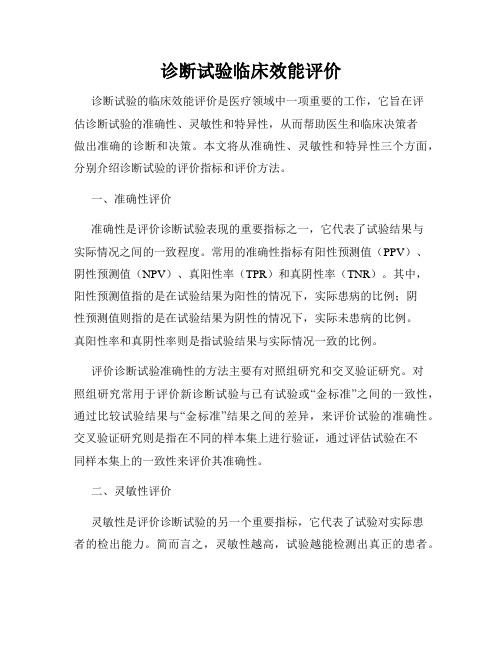
诊断试验临床效能评价诊断试验的临床效能评价是医疗领域中一项重要的工作,它旨在评估诊断试验的准确性、灵敏性和特异性,从而帮助医生和临床决策者做出准确的诊断和决策。
本文将从准确性、灵敏性和特异性三个方面,分别介绍诊断试验的评价指标和评价方法。
一、准确性评价准确性是评价诊断试验表现的重要指标之一,它代表了试验结果与实际情况之间的一致程度。
常用的准确性指标有阳性预测值(PPV)、阴性预测值(NPV)、真阳性率(TPR)和真阴性率(TNR)。
其中,阳性预测值指的是在试验结果为阳性的情况下,实际患病的比例;阴性预测值则指的是在试验结果为阴性的情况下,实际未患病的比例。
真阳性率和真阴性率则是指试验结果与实际情况一致的比例。
评价诊断试验准确性的方法主要有对照组研究和交叉验证研究。
对照组研究常用于评价新诊断试验与已有试验或“金标准”之间的一致性,通过比较试验结果与“金标准”结果之间的差异,来评价试验的准确性。
交叉验证研究则是指在不同的样本集上进行验证,通过评估试验在不同样本集上的一致性来评价其准确性。
二、灵敏性评价灵敏性是评价诊断试验的另一个重要指标,它代表了试验对实际患者的检出能力。
简而言之,灵敏性越高,试验越能检测出真正的患者。
灵敏性的评价常用的指标是真正阳性率(TPR),也称为召回率或敏感性。
它表示试验对真正患者的检测比例。
评价诊断试验灵敏性的方法主要有“金标准”对照和受试者工作特征曲线(ROC曲线)分析。
在“金标准”对照中,将试验结果与“金标准”结果进行对比,来评价试验的灵敏性。
ROC曲线分析则常用于评价试验结果的连续性,通过绘制曲线来显示不同阈值下试验的灵敏性和特异性。
三、特异性评价特异性是评价诊断试验的又一个重要指标,它代表了试验对非患者的判断能力。
特异性越高,试验越能排除非患者。
特异性的评价常用的指标是真正阴性率(TNR),即试验对真正非患者的判断比例。
评价诊断试验特异性的方法主要有独立样本验证和交叉验证。
诊断试验的评价

金标准:是指可以明确肯定或排除某种疾病 的最可靠的诊断方法,包括活体组织检查、手术 和尸体解剖等。
(1)*灵敏度(sensitivity):又称敏感性, 真阳性。
灵敏度 a 100% ac
灵敏度反映一项试验能将实际有病的人判定 为患病的能力,其值越大,则漏诊的可能性愈小。
假阴性互补
(2 ) *特异度(specificity):又称真阴性率。
2、百分位数法: 95%百分位数(120例)
3、ROC曲线法 4、实际工作:即前瞻性研究
(三)影响因素
研究对象 环境因素 操作 统计学处理问题
八、常见偏倚
1、工作偏倚: 阳性----金标准方法确诊 阴性-----不用
则产生偏倚
2、缺乏非病人群试验结果的信息造成的偏倚 3、不明结果引起 4、测量偏倚 5、金标准不当引起偏倚
患病率:a+c/N
假阴性率 =1-灵敏度=7%
一致性 =(a+d)/(a+b+c+d) 100% =329/360 100%=91%
阳性预测值 =a/(a+b) 100%=215/231 100% =93%
阴性预测值 =d/(c+d) 100%=114/129 100% =88%
约登指数 =(灵敏度+特异度)-1=0.81
b —— c —— a ——
人 正常人 数
a bc
病人
假阴性
假阳性
点点点 误漏误 诊诊诊 率(( =假假 漏阴阳 诊性性 率))
增增 大大
(3)原则:
高灵敏度试验适用于 A:病严重但可治 ,尤早期最好。结核 B:排除某病 C:发病率低的病排除。阴性时可排除。 高特异度试验适用于: A:无法治疗的疾病。如癌,阳性结果会导致病人
诊断试验的评价和ROC分析
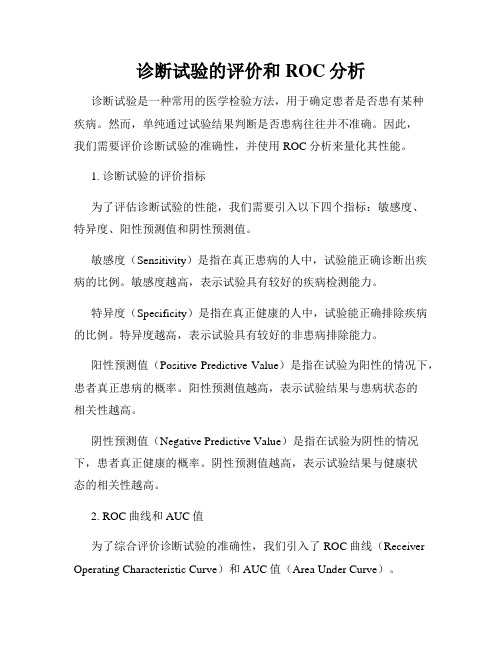
诊断试验的评价和ROC分析诊断试验是一种常用的医学检验方法,用于确定患者是否患有某种疾病。
然而,单纯通过试验结果判断是否患病往往并不准确。
因此,我们需要评价诊断试验的准确性,并使用ROC分析来量化其性能。
1. 诊断试验的评价指标为了评估诊断试验的性能,我们需要引入以下四个指标:敏感度、特异度、阳性预测值和阴性预测值。
敏感度(Sensitivity)是指在真正患病的人中,试验能正确诊断出疾病的比例。
敏感度越高,表示试验具有较好的疾病检测能力。
特异度(Specificity)是指在真正健康的人中,试验能正确排除疾病的比例。
特异度越高,表示试验具有较好的非患病排除能力。
阳性预测值(Positive Predictive Value)是指在试验为阳性的情况下,患者真正患病的概率。
阳性预测值越高,表示试验结果与患病状态的相关性越高。
阴性预测值(Negative Predictive Value)是指在试验为阴性的情况下,患者真正健康的概率。
阴性预测值越高,表示试验结果与健康状态的相关性越高。
2. ROC曲线和AUC值为了综合评价诊断试验的准确性,我们引入了ROC曲线(Receiver Operating Characteristic Curve)和AUC值(Area Under Curve)。
ROC曲线是以敏感度为纵轴,以1-特异度为横轴绘制的曲线。
曲线上每一个点表示了在不同阈值下的敏感度和特异度。
ROC曲线越靠近左上角,表示试验性能越好。
AUC值是ROC曲线下面积的数值,范围在0.5到1之间。
AUC值越接近1,表示试验具有较高的准确性。
3. 如何进行ROC分析进行ROC分析通常需要以下步骤:(1)收集样本数据:包括疾病阳性和阴性样本,以及其相应的试验结果。
(2)计算敏感度和特异度:根据试验结果计算敏感度和特异度,并绘制ROC曲线。
(3)计算AUC值:根据ROC曲线计算AUC值。
(4)选择最佳阈值:根据需求和实际情况,选择最佳的阈值以平衡敏感度和特异度。
诊断性试验的评价标准

诊断性试验的评价标准诊断性试验是评估一种诊断测试的准确性和可靠性的重要手段。
在临床实践中,正确的诊断结果对于患者的治疗和预后具有重要的指导意义。
因此,对于诊断性试验的评价标准具有至关重要的意义。
本文将从准确性、可靠性、灵敏度和特异性等方面对诊断性试验的评价标准进行探讨。
首先,准确性是评价诊断性试验的重要指标之一。
准确性包括阳性预测值和阴性预测值。
阳性预测值是指在所有被试验对象中,真正患病者被诊断为患病的比例,而阴性预测值是指在所有被试验对象中,真正非患病者被诊断为非患病的比例。
准确性高意味着诊断性试验能够准确地识别出患病者和非患病者,对于临床诊断具有重要的指导意义。
其次,可靠性是评价诊断性试验的另一个重要指标。
可靠性包括重复性和稳定性。
重复性是指在相同条件下,同一检测者对同一被试验对象进行多次测试,结果之间的一致性程度。
稳定性是指在不同条件下,不同检测者对同一被试验对象进行测试,结果之间的一致性程度。
可靠性高意味着诊断性试验具有较好的重复性和稳定性,能够提供可靠的诊断结果。
此外,灵敏度和特异性也是评价诊断性试验的重要指标之一。
灵敏度是指在所有真正患病者中,被试验对象被诊断为患病的比例。
特异性是指在所有真正非患病者中,被试验对象被诊断为非患病的比例。
灵敏度高意味着诊断性试验能够准确地识别出患病者,而特异性高意味着诊断性试验能够准确地识别出非患病者。
灵敏度和特异性是相互矛盾的指标,提高灵敏度可能会降低特异性,反之亦然。
因此,在实际应用中需要根据具体情况进行权衡。
综上所述,诊断性试验的评价标准包括准确性、可靠性、灵敏度和特异性等方面。
在进行诊断性试验时,需要综合考虑这些指标,选择合适的评价方法,以确保诊断性试验能够提供准确可靠的诊断结果,为临床诊断和治疗提供科学依据。
诊断试验评价范文

诊断试验评价范文首先,评价指标是诊断试验评价的核心内容之一、评价指标可以分为准确度指标、可靠度指标、临床应用性指标和经济性指标等。
准确度指标包括灵敏度、特异度、阳性预测值和阴性预测值等,用于衡量诊断试验的准确性。
可靠度指标包括重测信度、平行测度和一致性等,用于评估诊断试验的稳定性和可靠性。
临床应用性指标包括预后价值、治疗决策和疾病负担等,用于评估诊断试验在临床应用中的效果和意义。
经济性指标包括成本效益比和成本效用比等,用于评价诊断试验在经济方面的可行性。
其次,研究设计是诊断试验评价的重要环节之一、常见的研究设计包括横断面研究、队列研究和病例对照研究等。
横断面研究用于评价诊断试验的准确性,通过比较试验结果和金标准结果等,计算评价指标。
队列研究用于评价诊断试验的预测能力,通过建立一组有相关疾病危险因素的人群,进行长期的随访观察,计算评价指标。
病例对照研究则通过回顾性的方法,选择病例和对照组,计算评价指标。
合理的研究设计能够保证评价结果的准确性和可靠性。
此外,研究样本的选择和有效性是诊断试验评价的重点。
研究样本应具有代表性,能够反映目标人群的特征和分布情况。
研究样本的大小也需要合理确定,以保证评价结果的统计学意义和实用性。
另外,评价结果的可靠性和有效性也需要通过统计分析和结果验证来进行验证。
常用的验证方法包括内部验证和外部验证。
内部验证是通过交叉验证、Bootstrap方法等来验证评价结果的稳定性和可靠性。
外部验证则是通过多中心、多样本的研究来验证评价结果的适用性和推广性。
最后,诊断试验评价的结果应进行整体解释和应用。
评价结果应结合临床实际和科研需要进行解读,并尽可能给出建议和指导。
此外,评价结果还应被广泛应用于临床实践和政策制定中,以提高诊断的准确度和效果。
总之,诊断试验评价是一项复杂而重要的工作。
通过合理的评价指标、科学的研究设计、合适的样本选择和有效的结果验证,可以对诊断试验进行全面评价,并提供可靠的依据和指导。
诊断性试验的设计与评价

特异性越高,则假阳性率越低,假阳 性率等于误诊率。因此,特异性高的 试验,用于临床时误诊机会少。高特 异性试验,用于肯定诊断、确诊疾病。 当试验结果阳性时,临床确诊价值最 大。
用高特异性试验,阳性结果肯定诊断, 又称为SpPins。
特异性高的试验适用于:
肯定疾病的诊断;
凡假阳性结果会导致病人精神负担, 或不当防治措施会给病人带来严重危17
4. Spe=Spe1 X Spe2
5. 验后比=验前比 X LR1 X LR2
25
联合试验
2. 序列试验: 依次相继的试验,要所有的试验
阳性才能做出诊断。序列试验提高了特异度 及阳性预测值。但降低了敏感度及阴性预测 值。
3. 例如: 诊断心肌梗死的CPK、AST、LDH,没
有一种试验是很特异的,如采用序列试验, 即三项均阳性才能诊断,这样可提高诊断心 肌梗死的特异度。
进行比较。 新的诊断性试验,应该具备方法更为简便、
更为可靠或者减少危险、减少创伤、节约费 用等优点,这样的诊断性试验才具有推广意 义。
4
二、评价诊断性试验的条件
3。列出四格表
诊 断
+
性
试 验
-
标准诊断
有病
无病
a(真阳性) b(假阳性)
c(假阴性) d(真阴性)
5
必须用评价的资料列出四格表, 方法如下
12
如果扩大检查范围,将该地全体运动员都 作上述检查,结果如表2:
冠状动脉狭窄>75%
是
否
运动心电图+ 55(a) 42(b) 97
- 49(c) 478(d) 527
104
520 624
13
SEN=55/104=53%(不变) SPE=478/520=92%(不变) ACC=(55+478)/624=85%(增加20%, 14个 百分点) +PV=55/97=57%(下降38%, 32个百分点) -PV=478/527=91%(增加44%, 28个百分 点) PREV=104/624=17%(原为53%) +LR=0.53/(1-0.92)=6.6(不变) -LR=(1-0.53)/0.92=0.51(不变) 阳性率=97/624=15%(下降52%, 16个百 分点)
诊断试验评价指标

· 阳性预测值(positive predictive value,+P 假如诊断试验结果是阳性病人真正有病的 可能性。
· 计算公式:+PV=a / ( a +b ) · 反映诊断指标阳性时患者患某病的概率。
•2021/1/12
•5
诊断试验的综合评价指标
· 阴性预测值(negative predictive value,-P 假如试验结果是阴性,病人真正无病的概
•13
Thank You
†世界触手可及
ห้องสมุดไป่ตู้
率
· 计算公式:-PV=d / (c +d )
· 反映诊断结果阴性时受试者不会患某病的
概率
•2021/1/12
•6
诊断试验的综合评价指标
· 总符合率〔 〕 · 计算公式: =(a+d)/(a+b+c+d) · 表示观察值与标准值或真实值符合的程
度
•2021/1/12
•7
诊断试验的综合评价指标
· 阳性似然比(positive likelihood ratio,PLR 指真阳性率与假阳性率之比,说明病人中 出现某种检验结果阳性的概率是非病人的 多少倍,即一项试验按某已定标准判断某 病人结果为阳性
诊断试验评价指标
诊断试验的评价指标
· 根本指标
· 灵敏度、特异度
· 预测值
· 阳性预测值、阴性预测值
· 综合评价指标
· 总符合率、阳性似然比、阴性似然比
· 差异性检验
· 配对卡方检验、Kappa系数
•2021/1/12
•2
诊断试验评价的根本指标
·灵敏度〔Sensitivity,Se〕 是试验发现 有病的人的才能,即实际诊断为有病的病 例中,诊断试验结果为阳性例数的比例。 ·计算公式:Se =a/(a+c) ·又称真阳性率 ·将实际有病的人正确判断为患者的才能
诊断性试验的评价标准

诊断性试验的评价标准诊断性试验是指通过对疾病或病变进行检测和分析,以便及时准确地进行诊断的一种临床实验。
在进行诊断性试验时,评价标准是非常重要的,它可以帮助我们准确地评估试验的有效性和可靠性。
本文将就诊断性试验的评价标准进行探讨。
首先,诊断性试验的评价标准应包括灵敏度和特异度。
灵敏度是指在疾病存在的情况下,试验能够正确识别出阳性结果的能力;特异度是指在疾病不存在的情况下,试验能够正确识别出阴性结果的能力。
灵敏度和特异度是评价诊断试验准确性的重要指标,它们直接影响了试验结果的可信度和可靠性。
其次,评价标准还应包括阳性预测值和阴性预测值。
阳性预测值是指在试验结果为阳性的情况下,被检测者真正患有该疾病的概率;阴性预测值是指在试验结果为阴性的情况下,被检测者真正不患有该疾病的概率。
阳性预测值和阴性预测值是评价试验结果对个体诊断价值的重要指标,它们可以帮助我们更好地理解试验结果所传达的信息。
此外,评价标准还应考虑到试验的重复性和稳定性。
重复性是指在相同条件下,试验能够重复出相似的结果;稳定性是指在不同条件下,试验能够产生一致的结果。
重复性和稳定性是评价试验可靠性和稳定性的重要指标,它们可以帮助我们判断试验结果是否具有可重复性和可靠性。
最后,评价标准还应考虑到试验的成本效益和实际应用情况。
成本效益是指在达到相同诊断效果的情况下,试验所需的成本与收益的比例;实际应用情况是指试验结果在临床实践中的应用效果和价值。
成本效益和实际应用情况是评价试验实用性和经济性的重要指标,它们可以帮助我们更好地理解试验结果在实际应用中的价值和意义。
综上所述,诊断性试验的评价标准是多方面的,需要综合考虑试验的准确性、可靠性、重复性、稳定性、成本效益和实际应用情况等因素。
只有综合考量这些因素,才能够全面评价试验结果的有效性和可靠性,为临床诊断提供更准确、更可靠的依据。
希望本文的内容能够对诊断性试验的评价标准有所帮助,谢谢阅读。
诊断试验临床应用评价研究
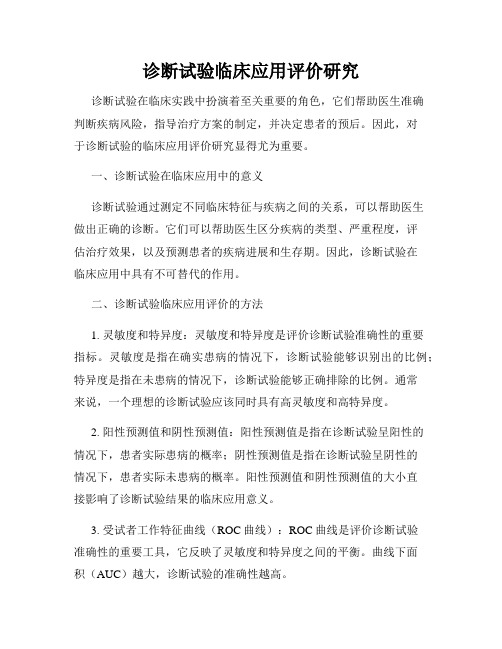
诊断试验临床应用评价研究诊断试验在临床实践中扮演着至关重要的角色,它们帮助医生准确判断疾病风险,指导治疗方案的制定,并决定患者的预后。
因此,对于诊断试验的临床应用评价研究显得尤为重要。
一、诊断试验在临床应用中的意义诊断试验通过测定不同临床特征与疾病之间的关系,可以帮助医生做出正确的诊断。
它们可以帮助医生区分疾病的类型、严重程度,评估治疗效果,以及预测患者的疾病进展和生存期。
因此,诊断试验在临床应用中具有不可替代的作用。
二、诊断试验临床应用评价的方法1. 灵敏度和特异度:灵敏度和特异度是评价诊断试验准确性的重要指标。
灵敏度是指在确实患病的情况下,诊断试验能够识别出的比例;特异度是指在未患病的情况下,诊断试验能够正确排除的比例。
通常来说,一个理想的诊断试验应该同时具有高灵敏度和高特异度。
2. 阳性预测值和阴性预测值:阳性预测值是指在诊断试验呈阳性的情况下,患者实际患病的概率;阴性预测值是指在诊断试验呈阴性的情况下,患者实际未患病的概率。
阳性预测值和阴性预测值的大小直接影响了诊断试验结果的临床应用意义。
3. 受试者工作特征曲线(ROC曲线):ROC曲线是评价诊断试验准确性的重要工具,它反映了灵敏度和特异度之间的平衡。
曲线下面积(AUC)越大,诊断试验的准确性越高。
三、诊断试验临床应用评价研究的意义诊断试验是临床诊断的基础,其准确性直接关系到患者的治疗效果和预后。
因此,对诊断试验进行临床应用评价研究,能够帮助医生更好地理解其在实践中的适用性,指导其在临床决策中的应用。
四、诊断试验临床应用评价研究的挑战1. 样本数量不足:由于临床研究的复杂性和费用的限制,有时样本数量不足会导致诊断试验的评价不够准确。
2. 患者多样性:不同人群之间的生理和病理变异性会影响诊断试验的结果,在评价研究中需要考虑到这种多样性。
3. 金标准缺失:有些疾病缺乏明确的“金标准”诊断方法,这使得诊断试验评价的难度增加。
五、诊断试验临床应用评价研究的前景随着医学技术的不断发展和研究方法的改进,诊断试验临床应用评价研究将会变得更加精准和可靠。
诊断试验的评价

无病的例数中,诊断试验结果为阴性的比例。
真实性(Validity)
Disease Status Present Test Positive Test Negative a c Absent b d a+b c+d
Sensitivity = a/(a+c) Specificity = d/(b+d)
2、选择适宜的灵敏度与特异度
(1)、一项好的诊断方法应该既没有漏诊也没有误诊,即100%的 正确诊断, A.理想的 正常人群与 糖尿病病人 血糖水平分 布 B.现实的 正常人群与 糖尿病病人 血糖水平分 布
灵敏度与特异度之间的关系则是 当其中一个升高时,另一个必然降低
血糖试验不同血糖水平阳性界值的灵敏度和特异度
表 血清肌酸磷酸激酶 测定诊断急性心肌梗死
血清磷酸 肌酸激酶 阳性 阴性 急性心肌梗死(金标准判定) 有 无 合计 225 24 249 249 25 121 146
合 计
250
145
395
一、基本原理(Basic principle)
构建四格表(Construct and interpret a 2X2 table):
Absent
b d b+d a+b c+d a+b+c+d
Sensitivity = a/(a+c)
•Sensitivity(SN) is the ability of the test to find people who have the disease (i.e., new test is positive when gold standard is positive)
Diagnostic Test Principle
诊断试验评价医学统计学专业技术
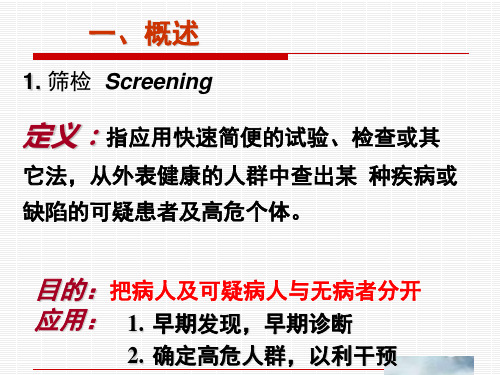
筛检试验 诊断试验
病人
非病人
筛检与诊断试验流程图
诊断试验的研究与评价:
诊断试验的研究与评价包括三方面内 容:确定医学参考值范围(正常值范 围);对诊断试验进行评价;确定诊 断标准。
诊断研究方法
1. 选择标准方法(金标准)
金标准(Gold Standard)
指的是一种公认的,可靠的能将有病和 无病分开的标准方法。。
b 假阳性
结果 阴性
c 假阴性
a+c
d 真阴性 b+d
4.假阳性率(误诊率)
假阳性率 =
b
b+d
×100%
a+b c+d
a+b+c+d
5. 约登指数 Youden’s index
又称正确指数,是评价真实性的综合指标 约登指数=灵敏度+特异度-1 (越接近1,越好)
金标准有病 金标准无病 合计
诊断试验阳性
可疑病人或病人
对可疑病人进行 确诊
科学性 精确性
实验 医疗仪器
筛检或诊断方法
问卷 体格检查 内镜检查 X线检查 血清学检查 生物化学 基因检查 病理切片检测
筛检与诊断的方法:
单项试验
试验数量 多项试验
并联:有“+”就阳性 串联:全“+”才阳性
普通筛检
筛检对象 选择筛检
5
行业技术
人群
健康者
可疑病人 或病人
a 真阳性
b 假阳性
a+b
诊断试验阴性
c 假阴性
d 真阴性
c+d
合计
a+c
b+d
n=a+b+c+d
评价诊断性试验的标准
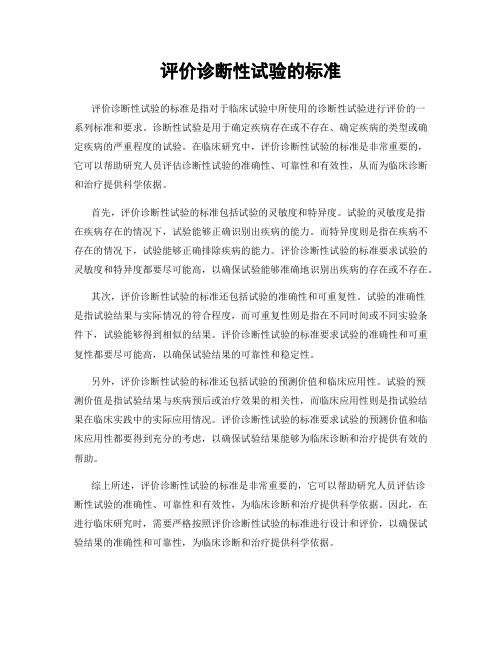
评价诊断性试验的标准评价诊断性试验的标准是指对于临床试验中所使用的诊断性试验进行评价的一系列标准和要求。
诊断性试验是用于确定疾病存在或不存在、确定疾病的类型或确定疾病的严重程度的试验。
在临床研究中,评价诊断性试验的标准是非常重要的,它可以帮助研究人员评估诊断性试验的准确性、可靠性和有效性,从而为临床诊断和治疗提供科学依据。
首先,评价诊断性试验的标准包括试验的灵敏度和特异度。
试验的灵敏度是指在疾病存在的情况下,试验能够正确识别出疾病的能力。
而特异度则是指在疾病不存在的情况下,试验能够正确排除疾病的能力。
评价诊断性试验的标准要求试验的灵敏度和特异度都要尽可能高,以确保试验能够准确地识别出疾病的存在或不存在。
其次,评价诊断性试验的标准还包括试验的准确性和可重复性。
试验的准确性是指试验结果与实际情况的符合程度,而可重复性则是指在不同时间或不同实验条件下,试验能够得到相似的结果。
评价诊断性试验的标准要求试验的准确性和可重复性都要尽可能高,以确保试验结果的可靠性和稳定性。
另外,评价诊断性试验的标准还包括试验的预测价值和临床应用性。
试验的预测价值是指试验结果与疾病预后或治疗效果的相关性,而临床应用性则是指试验结果在临床实践中的实际应用情况。
评价诊断性试验的标准要求试验的预测价值和临床应用性都要得到充分的考虑,以确保试验结果能够为临床诊断和治疗提供有效的帮助。
综上所述,评价诊断性试验的标准是非常重要的,它可以帮助研究人员评估诊断性试验的准确性、可靠性和有效性,为临床诊断和治疗提供科学依据。
因此,在进行临床研究时,需要严格按照评价诊断性试验的标准进行设计和评价,以确保试验结果的准确性和可靠性,为临床诊断和治疗提供科学依据。
诊断试验的评价(临床)

随着医学技术的不断发展和进步 ,新的诊断方法和手段层出不穷 ,对诊断试验的评价显得尤为重 要。
评价的重要性和意义
评价诊断试验的准确性和可靠性,有助于医生做出更准确的诊断和治疗决策,提高 患者的治疗效果和生存率。
通过评价诊断试验的性能指标,如灵敏度、特异度、预测值等,可以了解该试验的 优缺点,为临床医生提供有价值的参考信息。
结果解读
正确解读试验结果,结合临床信息和 其他检查结果进行综合判断,避免单 一指标导致的误诊或漏诊。
未来展望
精准医疗 随着精准医疗的发展,诊断试验 将更加个性化,针对不同人群和 疾病类型提供更准确的诊断方法。
液体活检 液体活检作为一种非侵入性的诊 断方法,具有广阔的应用前景, 未来将在肿瘤等疾病的早期诊断 中发挥重要作用。
高特异性意味着试验能够准确排 除大多数或所有未患病者,减少
假阳性结果的出现。
特异性与敏感性一样,是评估诊 断试验效能的重要指标之一。
准确性
准确性(Accuracy)是指诊断试 验正确识别患病者和未患病者的
总体能力。
高准确性意味着试验在总体人群 中能够准确区分患病者和未患病
者。
准确性综合了敏感性和特异性的 信息,是评估诊断试验整体性能
特异性
指诊断试验正确识别非病例的 能力,即真阴性率。
敏感性
指诊断试验正确识别病例的能 力,即真阳性率。
预测值
包括阳性预测值和阴性预测值,分 别表示试验结果阳性或阴性时,患 者真正患病或未患病的概率。
似然比
反映试验结果阳性相对于阴性 的患病概率增加的倍数。
诊断试验的优缺点
提供客观依据
通过量化指标为医生提供诊断依据,减少主观判断误差。
的重要指标。
诊断试验的评价和ROC分析
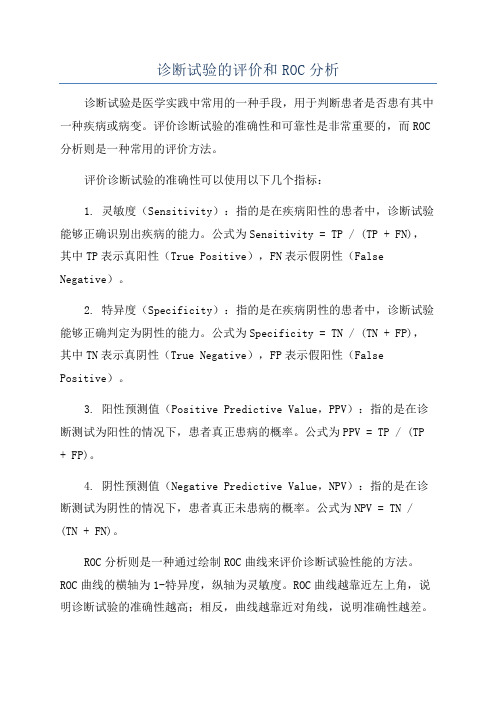
诊断试验的评价和ROC分析诊断试验是医学实践中常用的一种手段,用于判断患者是否患有其中一种疾病或病变。
评价诊断试验的准确性和可靠性是非常重要的,而ROC 分析则是一种常用的评价方法。
评价诊断试验的准确性可以使用以下几个指标:1. 灵敏度(Sensitivity):指的是在疾病阳性的患者中,诊断试验能够正确识别出疾病的能力。
公式为Sensitivity = TP / (TP + FN),其中TP表示真阳性(True Positive),FN表示假阴性(False Negative)。
2. 特异度(Specificity):指的是在疾病阴性的患者中,诊断试验能够正确判定为阴性的能力。
公式为Specificity = TN / (TN + FP),其中TN表示真阴性(True Negative),FP表示假阳性(False Positive)。
3. 阳性预测值(Positive Predictive Value,PPV):指的是在诊断测试为阳性的情况下,患者真正患病的概率。
公式为PPV = TP / (TP + FP)。
4. 阴性预测值(Negative Predictive Value,NPV):指的是在诊断测试为阴性的情况下,患者真正未患病的概率。
公式为NPV = TN / (TN + FN)。
ROC分析则是一种通过绘制ROC曲线来评价诊断试验性能的方法。
ROC曲线的横轴为1-特异度,纵轴为灵敏度。
ROC曲线越靠近左上角,说明诊断试验的准确性越高;相反,曲线越靠近对角线,说明准确性越差。
ROC曲线下面积(Area Under the Curve,AUC)可以评估诊断试验的整体性能。
AUC的取值范围为0.5-1,越接近1表示诊断试验越准确,AUC等于0.5表示诊断试验的准确性等同于随机猜测。
ROC分析还可以根据阈值来评估诊断试验的准确性。
当改变阈值时,诊断试验的灵敏度和特异度会发生变化。
根据所需的灵敏度和特异度,可以选择合适的阈值来进行诊断,并计算相应的PPV和NPV。
诊断试验的评价标准

诊断试验的评价标准诊断试验是临床医学中非常重要的一环,它可以帮助医生准确地判断病人的病情和疾病类型,从而制定出更加科学合理的治疗方案。
而要对诊断试验进行评价,就需要依据一定的标准和方法来进行。
本文将从准确性、精确性、灵敏度、特异性等方面来介绍诊断试验的评价标准。
首先,我们来谈谈准确性。
诊断试验的准确性是指试验结果与被试验对象的真实情况相符合的程度。
在评价准确性时,我们通常会使用灵敏度和特异性来进行衡量。
灵敏度是指在真正患病的个体中,试验能够检出病变的能力。
而特异性则是指在真正健康的个体中,试验能够排除病变的能力。
一个好的诊断试验应该具有较高的灵敏度和特异性,这样才能更好地帮助医生进行准确的诊断。
其次,精确性也是评价诊断试验的重要标准之一。
精确性是指在进行重复试验时,试验结果能够得到相似的程度。
一个精确度高的试验结果,意味着在不同的实验条件下,试验结果也是稳定可靠的。
这对于临床医生来说尤为重要,因为他们需要能够信任试验结果,从而做出正确的诊断和治疗决策。
此外,我们还需要考虑到试验结果的可重复性和稳定性。
一个好的诊断试验应该具有较高的可重复性和稳定性,这样才能够在不同的实验条件下得到相似的结果,从而增加试验结果的可信度和可靠性。
综上所述,评价诊断试验的标准主要包括准确性、精确性、灵敏度和特异性等方面。
只有在这些方面都能够得到较高的评价,我们才能够相信试验结果,从而为临床医生的诊断和治疗提供更加科学和可靠的依据。
在进行诊断试验时,我们应该注重这些评价标准,努力提高试验的质量,从而更好地服务于临床医学的发展和病人的健康。
诊断试验评价

诊断试验评价
诊断试验评价是医学统计学的一个重要领域,用于评估不同诊断试验
的准确性和可靠性。
在医学诊断中,准确地确定是否患有其中一种疾病对
于正确的治疗和预后非常重要。
不同的诊断试验包括实验室检验、影像学
检查和临床表现等,但它们的准确性会有所不同。
而正式的统计学方法可以用来评估诊断试验准确性。
其中,接受者操
作特征曲线(ROC)曲线被广泛用于评估治疗试验的准确性。
ROC曲线可
以反映不同敏感度和特异度的权衡关系。
曲线下面积(AUC)是评估ROC
曲线的一个指标,值越接近1表示试验准确性越高。
另一个常见的统计学方法是计算诊断试验的阳性和阴性似然比。
阳性
似然比是指在患有疾病的人中获得阳性结果的相对可能性,阴性似然比是
指在健康人中获得阴性结果的相对可能性。
似然比提供了一个数值来评估
试验结果的可靠性。
此外,还可以使用卡方检验来评估诊断试验的结果。
卡方检验用于比
较观察到的数据与期望数据之间的差异,可以帮助确定试验结果是否具有
统计学意义。
在进行诊断试验评价时,还需要考虑样本大小和疾病的流行率等因素。
样本大小对于准确性评估非常重要,较小的样本可能导致结果不可靠。
而
疾病的流行率也会影响敏感度和特异度的评估,因为试验结果可能存在偏差。
总之,诊断试验评价是医学统计学的一个重要领域,用于评估不同诊
断试验的准确性和可靠性。
通过使用严谨的统计学方法,可以帮助医生和
研究人员合理评估不同诊断试验的优劣,从而为临床决策提供科学依据。
诊断性试验的评价标准

诊断性试验的评价标准诊断性试验是临床医学中常见的一种研究设计,其目的是评估某种诊断测试在诊断特定疾病时的准确性和可靠性。
在进行诊断性试验时,需要对其评价标准进行严格的规范和要求,以确保试验结果的科学性和可靠性。
本文将围绕诊断性试验的评价标准展开讨论,以期为相关研究提供指导和参考。
首先,诊断性试验的评价标准应包括以下几个方面,灵敏度、特异度、阳性预测值、阴性预测值和受试者工作特征曲线(ROC曲线)等。
其中,灵敏度是指在真正患病者中,诊断测试能够正确识别出患病者的能力;特异度则是指在非患病者中,诊断测试能够正确排除非患病者的能力。
阳性预测值是指在测试结果为阳性时,被测试者真正患病的概率;阴性预测值则是指在测试结果为阴性时,被测试者真正非患病的概率。
ROC曲线则是通过绘制灵敏度和1-特异度的曲线来评估诊断测试的准确性和可靠性。
其次,评价标准的制定应考虑到疾病特点、研究对象和研究目的等因素。
不同的疾病可能对测试的要求有所不同,因此在评价标准的制定时需要充分考虑到疾病的特点和临床表现。
同时,研究对象的特点也会影响评价标准的制定,比如不同年龄段、性别、病情严重程度等因素都可能对测试结果产生影响。
此外,研究目的也是评价标准制定的重要考量因素,不同的研究目的可能对测试的要求有所不同,因此需要根据具体的研究目的来确定评价标准。
再次,评价标准的制定应遵循科学、客观、全面和可操作的原则。
科学性是评价标准的基本要求,评价标准应基于充分的科学依据和临床实践经验进行制定,确保其科学性和可靠性。
客观性是评价标准的重要特点,评价标准应尽量避免主观因素的干扰,确保评价结果客观可信。
全面性是评价标准的必备条件,评价标准应全面考虑测试的各个方面,确保评价结果全面准确。
可操作性是评价标准的实用性要求,评价标准应具有一定的操作性,方便研究人员进行测试和评价。
最后,评价标准的制定应注重标准化和规范化。
评价标准应尽量遵循国际或行业标准,确保评价结果的可比性和通用性。
《流行病学》7诊断试验评价

30
56
NPV (%) 50
80
95
88
3、诊断试验阳性结果截断值的确定
理想的诊断试验灵敏度、特异度均应 接近100%。
但在实际工作中很难达到,往往表现 为灵敏度↑↓则特异度↓↑。
两者高低的转换与确定诊断试验阳性 结果的截断值(cut off point)或临界点的 选择密切相关。
.
图7-3 病人与非病人观测值分布类型
评价指标
.
二、 诊断试验的评价
(一)评价方法
诊断试验的评价就是将待评价的诊 断试验与诊断目标疾病的标准方法——即 “金标准”(gold standard)——进行同步盲 法比较,判定该方法对疾病“诊断”的真实 性和价值。
.
确定“金标准”
“金标准”指当前临床医学界公认的诊断 疾病的最可靠的方法,也称为标准诊断金标
.
PPV
指试验阳性结果中真正患病(真阳性)的比例 阳性预 测 A 1 值 0 % 0 AB
NPV
指诊断试验阴性者不患目标疾病的可能性
阴性预 测 D 值 10% 0 CD
.
2、可靠性 (reliability)
也称信度、精确度(precision)或可重复性 (repeatability)
指在相同条件下用同一诊断试验对同一受试 者重复操作时获得相同结果的稳定程度
其次是选择研究对象,用金标准将这些对象划分 “有病(病例组)”与“无病(对照组)”;
第三,用待评价的诊断试验采用盲法同步地测试这 些研究对象,将获得的结果与金标准的诊断比较,应 用相应的指标来评价该试验的诊断价值。
.
金标准
目 标 人 群
+
病人
- 待评价的 诊断试验
- 1、下载文档前请自行甄别文档内容的完整性,平台不提供额外的编辑、内容补充、找答案等附加服务。
- 2、"仅部分预览"的文档,不可在线预览部分如存在完整性等问题,可反馈申请退款(可完整预览的文档不适用该条件!)。
- 3、如文档侵犯您的权益,请联系客服反馈,我们会尽快为您处理(人工客服工作时间:9:00-18:30)。
诊断试验的目的:
是把病人与可疑有病、但实际无病的人区 别开来,以便对确诊的病人给予相应的治
疗。
二、为什么要评价诊断试验
• 新的诊断试验方法不断被提出 • 现有诊断方法缺陷需要新的方法 • 对诊断结果的解释(指导临床实践)
阳性结果 阴性结果 是否受患病率的影响
上海医科大学临床流行病学中心 调查结果
c
d
c+d
a+c
b+d a+b+c+d
•Sensitivity(SN) is the ability of the test to find people who have the disease (i.e., new test is positive when gold standard is positive)
• By convention, the gold standard (truth) goes across the top and the new test goes to the side
• The four quadrants of the 2 X 2 represent true positives(TP), false positives (FP), false negatives(FN), and true negatives(TN).
Diagnቤተ መጻሕፍቲ ባይዱstic Test Principle
Disease Status (Gold Standard)
Present
Absent
Test Positive
Test Negative
Diagnostic Test Principle
Disease Status(Gold Standard)
是指诊断试验所获得的测量值与实际值 (“金标准”)的符合程度。
真实性指标:灵敏度,特异度,約登指数,
一致性,似然比
真实性(Validity)
Test Positive
Test Negative
Disease Status Present Absent
a
b
Sensitivity
= a/(a+c)
a+b
• 抽查了有关诊断试验评价的论著112篇
1985、1995年在5种中华医学会系列杂志发表
• 结果:90%以上的论著设计不合理
缺乏金标准:18篇进行评价 仅有阳性率:40篇(无敏感度、特异度等评价
指标) 用LR(似然比)和AUCROC(ROC曲线下面积):0
多数论著的设计:
• 选择一组病例,一组对照(其他病人或健康人), • 再应用新的诊断试验进行测定, • 然后两组比较了解其诊断价值。
临床流行病学对诊断试验评价的研究设计方法尚不 普及,许多临床医师对评价指标尚不了解,要提高我 国诊断试验评价的研究水平还需要做不少工作。
第二节 诊断试验的评价
一、基本原理(Basic principle)
金标准(Gold standard):这种公认的、可靠的、准 确的诊断方法,在诊断试验中称之为。 The best available test that is used as comparison is called the GOLD STANDARD
Present
Absent
Test Positive
Test Negative
True Negative (真阴性)
真阴性(True negative)是指用金标准方法已确诊未 患某病而用新方法试验也判定为阴性者。
Diagnostic Test Principle
Test Positive Test Negative
Test Positive
Present
True Positive (真阳性)
Absent
Test Negative
真阳性(True positive): 表示用金标准方法确诊患某 病而用新方法试验亦判定为阳性者;
Diagnostic Test Principle
Disease Status (Gold Standard)
诊断试验的评价
第一节 概述
一、诊断试验的概念
诊断试验(diagnostic test):是指应用实验、 仪器设备等手段对疾病进行诊断的一切检测 方法。
包括各种实验室检查(生物化学、免疫学、微生物 学、病理学等)、影像诊断(超声波、CT、X线、核 磁共振等)、仪器检查(心电图、脑电图、核素扫描、
内窥镜等),还包括病史询问、体格检查等。
Test Positive
Present
False Negative
Test Negative
(假阴性)
Absent
假阴性(False negative)是指用金标准方法确诊患 某病而用新方法试验却判定为阴性者。
第二节 诊断试验的评价
二、真实性(Validity):
真实性又称有效性或准确度(Accuracy ,
Disease Status (Gold Standard)
Present
Absent
False Positive (假阳性)
假阳性(False positive)是指用金标准方法确诊未患 某病而用新方法试验却判定为阳性者;
Diagnostic Test Principle
Disease Status (Gold Standard)
• 一、基本原理 (Basic principle )
①用金标准进行检查或检验,可将试验对象分为 两组,即金标准确诊的患某病组及金标准排除的未 患某病组。
②用新方法进行的诊断试验所得出的患病与未患 病的结果分别与金标准方法所得出患病与未患病的 结果比较,根据其是否一致对试验方法进行评价。
③如果新方法试验所得的结果与金标准试验所得 结果符合程度越高,这个新方法的诊断价值就越高, 反之亦然。
血清磷酸 肌酸激酶 阳性 阴性
合计
表 血清肌酸磷酸激酶
测定诊断急性心肌梗死
急性心肌梗死(金标准判定)
有无
合计
225 24
249
249
25 121
146
250 251045
395
一、基本原理(Basic principle)
构建四格表(Construct and interpret a 2X2 table):
如病理检查(活检、尸检)、手术探查、病原体的分离及抗体检测、 特殊影象学检查等。有些疾病尚无特异性诊断标准,则以专家制订、
得到公认的临床诊断标准为依据。
Need to remember that all gold standards are actually gold, though: new test may be better than the gold standard
